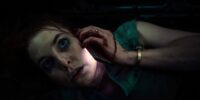One of the most powerful aspects of cinema is its ability to reflect the real world. Often times stories involve seasonal settings that relate directly to familiar sensory experience, whether conveyed through dates on a calendar or extreme climate. Viewers can enjoy the nostalgic feeling of horror or Halloween favorites during October, or films with Christmas cheer in December. They can watch Field of Dreams (1988) to get in the mood for baseball season. One of my favorite ways to match film setting to my own seasonal environment is during summer and winter. In the former you can pair the sweat-filled interiors of the sexy neo-noir Body Heat (1981) with Spike Lee’s midsummer classic Do The Right Thing (1989).
The most topical and enhancing pairing for me right now is watching films that excel in conveying the cold of winter. With much of North America engulfed in snow and cold temperatures, there is no better time to tune in to wintertime favorites. Winter is a great setting for any genre of films, but it seems to stick the best for horror, thrillers, and drama. Wind, snow, ice, and bitter cold are prime ingredients for isolation, desperation, and survival. The films I’m going to showcase all exhibit their own vital relationship with winter, and on their own all stand as excellent films. These are my favorite films that use winter as a setting with chilling effect.
The Thing (Carpenter, 1982)
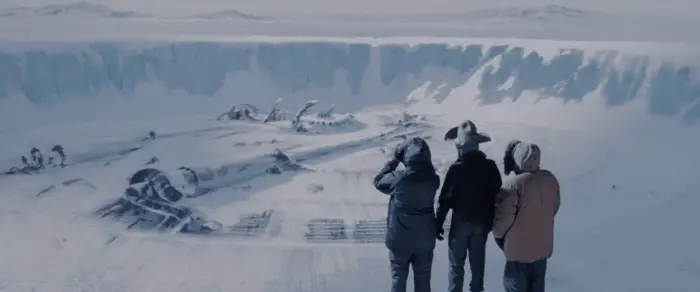
The Thing has the luxury of including the ultimate winter setting: Antarctica. Taking place on the frozen tundra continent, the seclusion and isolation may as well be setting the characters on the Moon. As winter begins, the men at a U.S. outpost can come and go only by helicopter, with no help for hundreds of miles around. Snow, wind, ice, and cold engulf almost every exterior shot. White washed landscapes cover the backgrounds and characters wear hats, thick coats, boats, and gloves.
When an alien craft crashes in the area of neighboring Norwegian out-posters, the cold is both ally for “The Thing” and potential refuge. Seeking out human hosts it puts the men at a terrifying disadvantage as they begin to not trust each other around camp. Survival for the hard winter can already be seen on the characters. MacCready (Kurt Russell) is one of a few with a big bushy beard to stay warm from the elements, a beard that becomes iced over the more time spent frantically outside during the film. The sound design whirls as the cold wind of a snow storm enters the area, and the low-lit Antarctic winter adds to the doom and gloom characters and audience feel alike. Fire often represents the only weapon the secluded men have for survival against a terrible alien looking to destroy them one by one through assimilation.
The Thing catches director John Carpenter after a bit of a hot streak from his horror masterpiece Halloween (1977) and cult classic Escape from New York (1981). The Thing is essentially a re-imaging of the 1979 sci-fi horror hit Alien, with a group of working-class workers needing to survive an alien infiltration in an isolated environment. Carpenter collaborates with Kurt Russell again as MacReady, a bold and rebellious leader within the camp. Veteran actors Wilfred Brimley and Keith David lend their supporting acting chops as the loose cannon Dr. Blair and inquisitive Childs, respectively.
Carpenter unleashes “The Thing” on his characters trapped in the winter confines of an isolated environment using classic techniques. Location shooting and refrigerated interior sets add authenticity to the frozen atmosphere of the story. Creature and make-up effects bring the gross and abject horror of the creature in different forms to the screen in a grotesque and realistic fashion. While the paranoia and desperation intensifies throughout the film, characters are killed off either by “The Thing” or with fire from the survivors at hand, culminating in a bold stroke of nihilism as MacCready and Childs stare at a destroyed-by-fire camp. Both characters know they can’t let the creature escape or freeze in the snow, and know they can’t trust each other (or perhaps even themselves). This classic sci-fi/horror film that thrills in the bitter cold would serve as inspiration for my next choice…
The Hateful Eight (Tarantino, 2015)
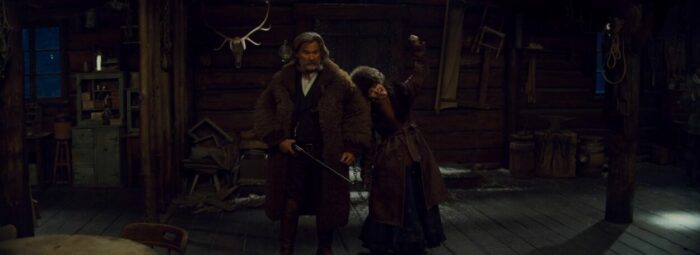
Set in the snowy Wyoming mountains, The Hateful Eight finds Tarantino trapping his characters and story in a snow-filled, wind-blown, frigid web. The point is made from the opening shot, a close-up of Jesus Christ on the cross covered in snow (seen at the top of this article). The first act takes place during a trek up the mountains in a horse-drawn carriage outrunning an impending blizzard, showcasing vast white vistas of mountain landscapes. The remainder takes place in the cold and claustrophobic Minnie’s Haberdashery. The drafty cabin acts as almost a stage play for the audience with the drama unfolding scene by scene. The sound design captures the whirling winds of the blizzard, and characters are knee deep in snow outside as they rush to seek warmth and refuge inside.
Tarantino built the set with air conditioning simulating a sold experience for the actors on set, and their breath can be seen on screen to sell the cold temps. Thick coats, scarves, and hats for the characters also enrich the verisimilitude of a cold, snowy night on the mountain. The warmth of hot coffee (be careful) and a pot of stew act as refuge for the characters isolated in their predicament. Stagecoach driver O.B. (James Parks) provides a bit of dark humor showcasing the bitter cold temps. He returns from a task outside to the inside the cabin and dramatically wrapping himself in blankets and curling up by the warm fire. Major Warren (Samuel L. Jackson) tells a tale of ice cold desperation, as he attempts to provoke General Smithers (Bruce Dern) into confrontation with the story of him torturing the Generals son on the mountain. Tarantino establishes that in his story, the cold elements can kill just as much as the cruel characters he unleashes.
The Hateful Eight is further example of how well Tarantino can write and direct twisted but compelling stories. He shows homage frequently to The Thing (1982), with a frozen single setting plot starring Kurt Russell and scored by Ennio Morricone. The cast is filled with usual Tarantino favorites led by Russell, Jackson, Tim Roth, Michael Madsen, and Jennifer Jason Leigh. The story follows a bounty hunter, hangman, and sheriff all aiming to get to Red Rock for their own business. When a winter storm forces them to stay in a mountain cabin with some mysterious characters, the drama unfolds with twists and turns. Setting the film in a cold and dreary single location allows Tarantino to amp up the tension and flex his instincts for blocking and dialogue.
The cinematography from Robert Richardson (shot in Ultra Panavison 70 for a 2.76:1 ratio) weaves around Minnie’s Haberdashery at various angles and compositions, all reinforcing characters and story development. Morricone’s score evokes the appropriate dread for the occasion. Tarantino intertwines post-civil war politics, deception, and unreliable narrators to flesh out his despicable characters into a pleasing metaphor of life-or-death chess inside an isolated space. This film always demands a rewatch for me this time of year, as I see no better way to pair my own environment with the settings within an intense well-crafted drama.
The Girl with the Dragon Tattoo (Fincher, 2011)
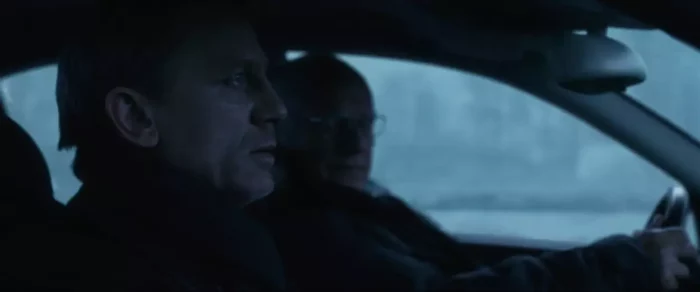
“We come from the land of the ice and snow…” blasts out the speakers in the opening credits, with Karen O and Trent Reznor covering “The Immigrant Song” by Led Zeppelin. Director David Fincher announces the season immediately in his neo-noir adaptation of the Stieg Larson novel of the same name. While the story in the film doesn’t always take place during winter, its impact is without a doubt felt when there. It starts out in Stockholm, Sweden during winter where jackets and hats are seen, but the harshness of winter doesn’t sink its teeth into the characters until journalist Mikael Blomkvist (Daniel Craig) travels to rural Hedestad in northern Sweden where the cold is not just seen but felt.
Cinematographer Jordan Cronenweth shoots these scene with soft, cool-colored light that is rarely direct. As the lead, Daniel Craig sells the cold setting of the island that the Vanger family inhabits very well. He is shivering as soon as he is picked up by a car or steps off the train from Stockholm. His girlfriend Erika Berger (Robin Wright) even comments about the freezing cold on her arrival in one scene. Blomkvist spends early scenes during the investigation trudging through snow, breathing on the end of his pen to make it write, and ripping pages of books to help make a fire in his dreadfully cold guest cottage. The isolation of dead-of-winter Sweden adds to the dread and subject matter found within the story.
The Girl with the Dragon Tattoo intertwines two narrative threads. First is recently disgraced journalist Mikael Blomkvist being tasked by businessman Henrik Vanger to help investigate the mystery behind his niece Harriet disappearance for 40 years. Blomkvist must look at events of the past and interview in the present the estranged Vanger family living on the remote Swedish island. Secondly, Blomkvist develops a unique relationship with his smart but complicated research assistant Lisbeth Salander (Rooney Mara). The film tackles themes of misogyny, violence towards women, and abusive control.
Fincher is no stranger to neo-noir material, with much of his filmography tackling similar dark and thrilling narratives. He is uniquely qualified to adapt this book to the big screen with his superb craft and skillset. Fincher uses much of the same obsessive procedural styles he used in Zodiac (2007). Flashbacks and scenes of characters pouring over evidence engage the viewer along as secrets and puzzle pieces are placed together. His direction for the two leads Craig and Mara bring their chemistry to the forefront. The Reznor/Ross musical score gives the film a beating heart of dread and momentum that matches the razor sharp editing of Baxter/Wall. Fincher and his cast/crew bring this visceral story to life during the harsh winter climate, engaging viewers along a ride of tragedy and unlikely friendship.
The Revenant (Iñárritu, 2015)
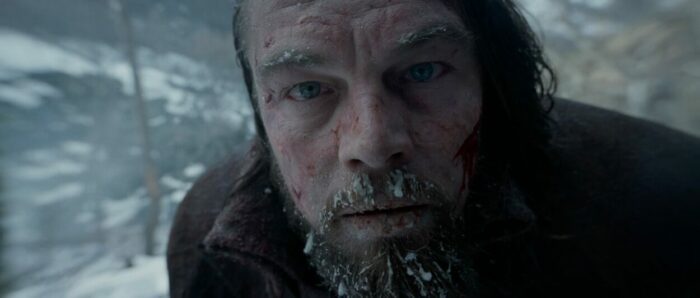
Set in the 1820s Dakotas on the cusp on winter, The Revenant is one of the defining examples of how to use the harsh elements of winter for character survival. Fur-trader Hugh Glass (Leonardo DiCaprio) finds himself stranded and alone after a bear attack leaves him for dead. His two motivations to get back to civilization are for survival and revenge against the man who killed his son and abandoned him to die in the mountain wilderness. The film uses heavy snow, wind, and ice to its deadly advantage. American trappers/fur-traders, French hunters, and the Arikara natives all dress warmly for the occasion. Furs, hats, coats, and boots of any sort are vital to surviving winter.
Glass goes to great measures to survive miles and days alone in the winter wilderness—eating roots, bison meat, and finding warmth in horse carcass among them. Guns, knives and fire are the only defense against the deadly grizzly bears and wolves. Almost all the characters in the film know how to survive in the Dakotas during the winter, but they still look haggard nonetheless. Glass’s journey from a shallow grave to his end point of revenge through a gauntlet of winters worst from frozen lakes to snowy mountain passes makes for quite a a chilling experience.
Director Alejandro Iñárritu bring his usual stylish flare to a simple story highlighted by great performances from DiCaprio and Tom Hardy as villain John Fitzgerald. Cinematographer Emmanuel Lubezki collaborates with Iñárritu again and shows how his skills to display wondrous wide shot landscapes in the on-screen shooting. Lubezki keeps his camera fluid throughout most scenes, and with long takes (an Iñárritu signature) he grounds the realism of the story and a characters. The production design of the film creates a precise 1820s winter western verisimilitude.
DiCaprio gives a gritty and tremendous physical performance for his Academy Award-winning role. Hugh Glass does not have much dialogue in the film, so DiCaprio gives his all with facial expression and physical exertion while fighting off a bear and subsequent survival tactics. While I maintain he has had better performances that should have been rewarded before this one, his win is still validated. Tom Hardy brings a stellar heel turn as the scummy trapper John Fitzgerald. The film also does a fine job of casting for the Arikara natives and brief ally of Glass’s, the Pawnee refugee Hikuc (Arthur Redcloud). The Revenant as a whole shows off the technical skills of its talented crew and the lengths Leonardo DiCaprio will go for the ultimate career validation in a harsh winter setting.
Grumpy Old Men (Petrie, 1993)

Location shooting, clothing, and production design all bring to life the small Minnesota town of Wabasha to life. Snow covers the ground, houses, vehicles, and sidewalks. Actors are covered head to toe in boots, coats, gloves, scarves, hats, and of course….buffalo-plaid flannel (a Midwest fashion staple). Max Goldman (Walter Matthau) and John Gustafson (Jack Lemmon) are two Minnesota lifers whose sole existence revolves around surviving the cold winters of Minnesota. Whether it being riding around the streets/hills in a snowmobile or driving out on the lake (yes, this is a thing) to their ice fishing shacks, Minnesotans of all ages brave the cold in their daily lives. Grumpy Old Men does a terrific job of showing how those in the upper Midwest handle hard winters.
Grumpy Old Men relies heavily on the acting and comedic chops of veteran actors Walter Matthau, Jack Lemmon, and Ann Margaret. Serving as a light-hearted romantic comedy, the film showcases the lives of two retired men living day-by-day as ice fisherman and duelists of verbal insults between each other as life long friend/rivals. Director Donald Petrie does a fine job of showing daily mundane rural Minnesota life, working off the familiar characters that writer Minnesota native Mark Steven Johnson bases them on. The late career star power combined with the familiarity of the story, jokes, and scenes is what makes the film a hit with audiences.
After decades together as a comedic duo, Matthau and Lemon bring their A-game to liven up their characters with insults, pranks, and heart warming catharsis. Ann Margaret injects energy and passion to the film as Ariel, the out-going and love interest for the two widowered neighbors. The story embraces and uplifts the setting of a Minnesotan winter from the get-go with the tongue-in-cheek use of “Heat Wave” to open the film after a snow plow drives down a street. Characters in the film are never shown discouraged with their winter habitat, living their lives as is and finding hobbies to enjoy it to the fullest. Sidewalks need to be shoveled, car windshields scraped, and frosted windows are used as voyeuristic viewpoints in the night. There are few comedic films that can showcase winter life in Minnesota quite like Grumpy Old Men.
Ope! Perhaps there is a dark comedy from 1996 that can…
Fargo (Coen Brothers, 1996)
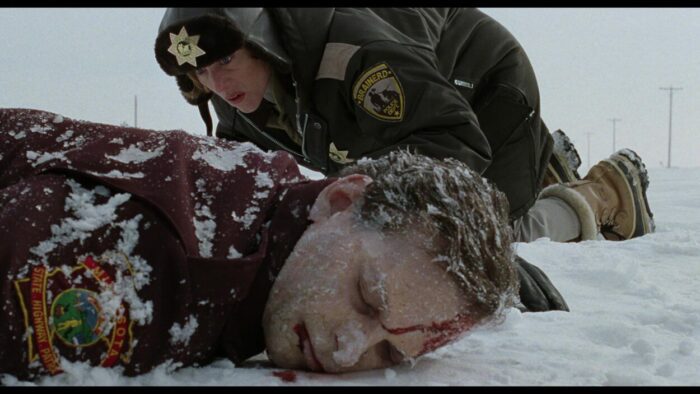
Born and raised in Minnesota, Joel and Ethan Coen are uniquely qualified to set a neo-noir in their snow covered home state with all the meticulous details. From the opening shot of the film, cinematographer Roger Deakins composes a winter whiteout setting a tow truck brings a tan Sierra down the road to Carter Burwell’s thunderous Fargo score. Despite the name of a North Dakota city, much of Fargo takes places near Brainerd and Minneapolis, MN. Accents are thick and exaggerated for comedic effects. Snow is thick and deep, covering the landscapes like sand desert in a Western. Hats, coats, gloves, and boots are worn in nearly every scene.
Plucky and pregnant police officer Marge Gunderson (Frances McDormand) needs a “jump” for her police prowler because of the bitter cold temps early in the morning. Her painter husband Norm (John Carrol Lynch) makes plans to ice fish on Lake Mille Lacs in the afternoon. Sketchy car saleman Jerry Lundegaard is shown taking out his frustrations from a failed deal on his iced over windshield that needs scraping, a heart ache most Minnesotans have felt. The Coens cleverly set up their crime filled ode to noir films not in an asphault jungle, but in the setting of “Minnesota Nice” rural winter wonderland.
What makes the film memorable?
As writer/director/editors for most of their filmography, few directing entities have full auteur control of film making like the Coen Brothers. By 1996 they had grown a reputation for cleverly crafted odes to noir and slapstick comedies of Preston Sturgess from the golden age of cinema. Fargo would bring a dark comedy to a Minnesotan winter. With Frances McDormand in the lead as Marge Gunderson, a persistent and good hearted police officer, they would contrast it with the scheming car salesman Jerry Lundegaard and criminal kidnappers Carl (Steve Buschemi) and Gaear (Peter Stormare). The Coens employ the talent of cinematographer Roger Deakins to capture the beautiful and vast white landscapes of rural Minnesota.
Fargo won two Academy Awards in 1996, one for best original screenplay and for best lead actress with McDormand. The film sends ordinary people down dark paths of corruption, greed, and sometimes murder. Dead bodies and blood contrasting with the white snow showcase how deadly and desolate winter can be, especially with the dark nature of men. Marge Gunderson closes the film in her police prowler exposing the evil acts in the film, and the fruitless pursuit of a little money. After the release of Fargo people from all over the world would think different about Minnesota, both for the funny exaggerated accents but also the potential for something much more dark and sinister among that beautiful, white snow.
Honorable Mentions
- The Shining (1980) —The Shining is Kubrick classic that displays how isolation can contribute to madness. It doesn’t quite make the list since only the 3rd act involves winter, but the impact deserves a mention. The maze scene with Jack and Danny is a great use of winter in film.
- The Day After Tomorrow (2004) — The Emmerich disaster movie isn’t good enough to make the list on merit, but it does have some good scenes about how winter and extreme cold (Hurricane blizzards?) can have a big impact on screen.
- Winter’s Bone (2010) —– Jennifer Lawrence’s breakthrough performance. The film would make the list on merit but I don’t feel its use of winter is quite cold and snowy enough to qualify (despite the title).
- Inside Llewyn Davis (2012) — This underrated Coens gem is definitely good enough to make the list on merit but needed a few more scenes of winter impact. The perpetually underdressed title character always seems to be cold and unprepared for winter, so it gets a nod for being very close.
To close things out, I hope this list gives audiences an idea of how to pair story environment with their own situations. Much of the northern hemisphere is deep into the cold of winter right now, and pairing some of these winter favorites with a warm cup of tea or coffee can do wonders to enhancing what each film can offer. The use of winter in films teaches us about fun, isolation, survival, and despair. Adding the extra degree of viewing a horror/thriller/comedy while we are also dealing with cold weather issues can do wonders for our viewing experiences.



